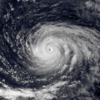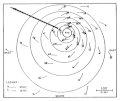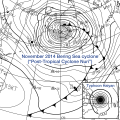Portal:Tropical cyclones
The Tropical Cyclones Portal

A tropical cyclone is a storm system characterized by a large low-pressure center, a closed low-level circulation and a spiral arrangement of numerous thunderstorms that produce strong winds and heavy rainfall. Tropical cyclones feed on the heat released when moist air rises, resulting in condensation of water vapor contained in the moist air. They are fueled by a different heat mechanism than other cyclonic windstorms such as Nor'easters, European windstorms and polar lows, leading to their classification as "warm core" storm systems. Most tropical cyclones originate in the doldrums, approximately ten degrees from the Equator.
The term "tropical" refers to both the geographic origin of these systems, which form almost exclusively in tropical regions of the globe, as well as to their formation in maritime tropical air masses. The term "cyclone" refers to such storms' cyclonic nature, with anticlockwise rotation in the Northern Hemisphere and clockwise rotation in the Southern Hemisphere. Depending on its location and intensity, a tropical cyclone may be referred to by names such as "hurricane", "typhoon", "tropical storm", "cyclonic storm", "tropical depression" or simply "cyclone".
Types of cyclone: 1. A "Typhoon" is a tropical cyclone located in the North-west Pacific Ocean which has the most cyclonic activity and storms occur year-round. 2. A "Hurricane" is also a tropical cyclone located at the North Atlantic Ocean or North-east Pacific Ocean which have an average storm activity and storms typically form between May 15 and November 30. 3. A "Cyclone" is a tropical cyclone that occurs in the South Pacific and Indian Oceans.
Selected named cyclone -
Hurricane Kenna was the fourth-most intense tropical cyclone on record in the Eastern Pacific basin, and at the time the third-most intense Pacific hurricane to strike the west coast of Mexico. Kenna was the sixteenth tropical depression, thirteenth tropical storm, seventh hurricane, sixth major hurricane, and third Category 5 hurricane of the 2002 Pacific hurricane season. After forming on October 22 to the south of Mexico from a tropical wave, forecasters consistently predicted the storm to strengthen much less than it actually did. Moving into an area of favorable upper-level conditions and warm sea surface temperatures, Kenna quickly strengthened to reach peak winds of 165 mph (270 km/h) as a Category 5 hurricane, on October 25, while located about 255 mi (410 km) southwest of Puerto Vallarta, Jalisco. Weakening as it turned to the northeast, the hurricane made landfall near San Blas, Nayarit as a Category 4 hurricane, with sustained winds of 140 mph (220 km/h), before dissipating on October 26 over the Sierra Madre Occidental mountains.
The name "Kenna" was retired from the list of Pacific hurricane names due to its effects on Mexico, which included US$101 million in damage and four deaths. The worst of the hurricane's effects occurred between San Blas in Nayarit and Puerto Vallarta in Jalisco, where over 100 people were injured and thousands of homes and businesses were damaged or destroyed. 95% of the buildings in San Blas were damaged, and hundreds of buildings were destroyed along coastal areas of Puerto Vallarta. (Full article...)
Selected article -
The 1903 New Jersey hurricane, also known as the Vagabond Hurricane by The Press of Atlantic City, is the first and only known North Atlantic hurricane to make landfall in the state of New Jersey since records were kept starting in 1851. The fourth hurricane of the season, the cyclone was first observed on September 12 about 550 miles (890 kilometres) northeast of Antigua. It moved quickly westward, then later turned to the north-northwest, steadily strengthening to reach a peak intensity of 100 miles per hour (155 kilometres per hour), a Category 2 on the modern-day Saffir–Simpson scale. The hurricane weakened slightly before striking near Atlantic City, New Jersey, on September 16 with winds of 80 mph (130 km/h). It weakened over Pennsylvania and became an extratropical cyclone over western New York on September 17.
Rough surf and moderate winds from the hurricane capsized several ships along the East Coast of the United States; 30 people were left missing and presumed killed from a shipwreck in Chincoteague, Virginia. Along the coast, 57 people died due to the storm. In New Jersey, the hurricane caused heavy damage, particularly near the coast and in Atlantic City. Dozens of buildings were damaged or destroyed, and damage across the state totaled $8 million (1903 USD). In New York City, high winds disrupted traffic, closed businesses, and overturned wagons, with many windows and roofs damaged. On Long Island, President Theodore Roosevelt directly experienced the effects of the hurricane while on a yacht. The life of the president was briefly threatened by the rough conditions, though none on board the yacht suffered any problems from the hurricane. (Full article...)
Selected image -

Selected season -

The 1994 Pacific hurricane season was the final season of the eastern north Pacific's consecutive active hurricane seasons that started in 1982. The season officially started on May 15, 1994, in the eastern Pacific, and on June 1, 1994, in the central Pacific, and lasted until November 30, 1994. These dates conventionally delimit the period of each year when most tropical cyclones form in the northeastern Pacific Ocean. The first tropical cyclone formed on June 18, while the last system dissipated on October 26. This season, twenty-two tropical cyclones formed in the north Pacific Ocean east of the dateline, with all but two becoming tropical storms or hurricanes. A total of 10 hurricanes occurred, including five major hurricanes. The above average activity in 1994 was attributed to the formation of the 1994–95 El Niño.
Of note in this season is an unusual spree of very intense storms; the season was the first on record to see three Category 5 hurricanes, later tied in 2002 and 2018. Hurricanes Emilia, Gilma, John, and Olivia all reached a pressure below 930 millibars. Hurricane John was the farthest-traveling tropical cyclone on record at 13,180 km (8,190 mi). Elsewhere, Hurricane Rosa caused four casualties in Mexico as the basin's only landfalling tropical storm or hurricane, and later was responsible for flooding in Texas. (Full article...)
Related portals
Currently active tropical cyclones

Italicized basins are unofficial.
- North Atlantic (2025)
- No active systems
- East and Central Pacific (2025)
- No active systems
- West Pacific (2025)
- No active systems
- North Indian Ocean (2025)
- No active systems
- Mediterranean (2024–25)
- No active systems
- South Atlantic (2024–25)
- No active systems
Last updated: 18:26, 5 February 2025 (UTC)
Tropical cyclone anniversaries

February 5
- 1977 - Cyclone Emilie moved ashore Mozambique, where flooding killed about 300 people.
- 2002 - Cyclone Chris (pictured) reached its peak intensity with 230 km/h (145 mph) winds before making landfall in a sparsely populated area of Western Australia.

February 6
- 2003 - Cyclone Beni (pictured) impacted the Queensland coast as a weakening system. Beni caused heavy flooding in Central Queensland that killed one person and caused $10 million of damage.

February 7
- 2005 - Cyclone Harvey made landfall on the Queensland-Northern Territory border as a Category 3 cyclone but caused only minor damage.
- 2009 - Cyclone Gael (pictured) reaches peak strength as an intense tropical cyclone off the coast of Madagascar. Only 2 people were killed by the cyclone.
Did you know…




- …that the Joint Typhoon Warning Center considers that Typhoon Vera (pictured) of 1986 is actually two distinct systems, formed from two separated low-level circulations?
- …that Cyclone Freddy (track pictured) in 2023 was the longest-lasting tropical cyclone recorded?
- …that the typhoons of 2024—Yinxing, Toraji, Usagi, and Man-yi (pictured)—made history as the first recorded instance since 1951 of four tropical cyclones coexisting in November?
- …that Hurricane Otis (pictured) in 2023 was the first Pacific hurricane to make landfall at Category 5 intensity and surpassed Hurricane Patricia as the strongest landfalling Pacific hurricane on record?
General images -

The 2015 North Indian Ocean cyclone season was a below-average tropical cyclone season which featured the highest number of deaths since the 2010 season. Despite inactivity in the Bay of Bengal caused by the ongoing El Niño, the season produced an above-average number of tropical cyclones in the Arabian Sea. The first storm of the season, Ashobaa, formed on 7 June, while the final storm of the season, Megh, ultimately dissipated on 10 November.
A total of twelve depressions were recorded, of which nine intensified into deep depressions. Of these nine, a total of four further strengthened into cyclonic storms, while two attained their peaks as extremely severe cyclonic storms. In early June, Cyclonic Storm Ashobaa produced significant flooding in eastern Oman and the United Arab Emirates. Later that month, Deep Depression ARB 02 resulted in the worst floods in the Amreli district of Gujarat in 90 years. The storm resulted in 80 deaths and an estimated 16.5 billion Indian rupees in damage in the state. In late July and early August, Cyclonic Storm Komen resulted in between 187 and 280 deaths in northeastern India, Bangladesh and Myanmar due to torrential rains as it slowly moved through the region. In early November, Extremely Severe Cyclonic Storm Chapala, the strongest storm of the season, became the first recorded tropical cyclone to produce hurricane-force winds in Yemen. During the storm's passage, areas in southern Yemen received 610 mm (24 in) of rainfall over 48 hours, or 700% of the average yearly precipitation. Just days after Chapala produced widespread damage in Yemen and the Puntland region of Somalia, Extremely Severe Cyclonic Storm Megh passed through the same region causing further destruction. Megh was judged to have been the worst tropical cyclone ever to affect the Yemeni island of Socotra, and resulted in 18 deaths on the island. The final storm of the season to form, Deep Depression BOB 03, produced significant flooding in southern India and resulted in at least 71 deaths in the region in early November. (Full article...)
Topics
Subcategories
Related WikiProjects
WikiProject Tropical cyclones is the central point of coordination for Wikipedia's coverage of tropical cyclones. Feel free to help!
WikiProject Weather is the main center point of coordination for Wikipedia's coverage of meteorology in general, and the parent project of WikiProject Tropical cyclones. Three other branches of WikiProject Weather in particular share significant overlaps with WikiProject Tropical cyclones:
- The Non-tropical storms task force coordinates most of Wikipedia's coverage on extratropical cyclones, which tropical cyclones often transition into near the end of their lifespan.
- The Floods task force takes on the scope of flooding events all over the world, with rainfall from tropical cyclones a significant factor in many of them.
- WikiProject Severe weather documents the effects of extreme weather such as tornadoes, which landfalling tropical cyclones can produce.
Things you can do
 |
Here are some tasks awaiting attention:
|
Wikimedia
The following Wikimedia Foundation sister projects provide more on this subject:
-
Commons
Free media repository -
Wikibooks
Free textbooks and manuals -
Wikidata
Free knowledge base -
Wikinews
Free-content news -
Wikiquote
Collection of quotations -
Wikisource
Free-content library -
Wikiversity
Free learning tools -
Wikivoyage
Free travel guide -
Wiktionary
Dictionary and thesaurus
























































